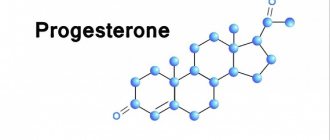Let's talk about female hormones, discuss the levels of hormones in the blood of women that affect sexual function.
The functioning of a woman’s reproductive system directly depends on the body’s production of hormones, some of which are produced directly by the gonads (ovaries) and adrenal glands, while others are produced in the part of the brain - the pituitary gland. It is hormones that influence how a woman’s menstrual cycle proceeds, whether she can become pregnant naturally, and whether she can bear a fetus.
general information
A woman's ovarian cycle and fertility are controlled by LH and FSH, and their secretion is controlled by sex hormones. Luteotropin stimulates ovarian activity to secrete estrogen. Its peak concentration stimulates the ovulatory process, as well as the process of luteinization, when the follicle becomes the corpus luteum (temporary endocrine gland). The corpus luteum produces progesterone, a hormone necessary for the successful attachment of the embryo to the endometriotic layer of the uterus. Therefore, if pregnancy does not occur, it is important to make sure that the progesterone test is normal. If implantation has occurred, then LH contributes to the normal functioning of the corpus luteum. LH stimulates the theca cells of the ovaries, which produce androgens (male gonadosteroids) from which estradiol is formed - the most active hormone from the estrogen group (read more about the hormone estradiol and how to properly take the test for women - note altravita-ivf.ru).
Under the influence of FSH, follicles form and mature, ovulation occurs with a peak release of follitropin, and libido decreases or increases. Gonadotropic hormones affect regulation, physical development, puberty, the appearance of secondary sexual characteristics, the ability to become pregnant, bear and give birth to a child.
Hormonal levels before pregnancy
Human vital activity is supported by more than 70 hormones that normalize various processes, activate the absorption of proteins, fats and carbohydrates, and destroy pathogenic substances. The lack of one or another hormone does not always immediately affect your well-being. Often a young woman does not notice health problems - her body is still full of strength, mild symptoms are ignored and attributed to PMS or fatigue. And only problems with conception or pregnancy reveal a serious hormonal imbalance.
Hormonal imbalance can cause miscarriage. Therefore, gynecologists advise undergoing an examination at the pregnancy planning stage and doing a hormone test before conception occurs. And not waste time for months looking at tests with one strip.
Hormonal influence on the menstrual cycle
Depending on the content of LH, FSH, and estrogens in the blood, the menstrual cycle in women is divided into three phases, one replacing the other:
- Follicular (menstrual) - average duration 2 weeks (7-22 days), the end of the ovarian cycle. It begins on the first day of menstruation, when the functional layer of the endometrium is shed, coming out with menstrual blood and glandular secretions. During this phase, the dominant follicle matures, which has the largest number of FSH receptors and produces estradiol more than other follicles. The menstrual phase ends with a sharp release of LH from the pituitary gland, which gives rise to the next phase - the ovulatory phase.
- Ovulatory (proliferative) phase - average duration is approximately 3 days. The dominant follicle finally matures and becomes a Graafian vesicle, capable of admitting the egg. The ratio of FSH and LH changes. The phase is characterized by a wave-like release of LH, which stimulates active substances (prostaglandins and enzymes) that promote rupture of the walls of the Graafian vesicle and the release of the egg, that is, ovulation. This period is characterized by a decrease in estradiol and the development (not in all cases) of ovulatory syndrome. Many women feel ovulation by the appearance of pain in the lower abdomen and lower back. Ovulation occurs after the peak release of luteinizing hormone within 16-48 hours. Follicular fluid (5-10 ml) comes out with the egg.
- The luteal (secretory) phase - the average duration is 2 weeks, this is the most stable period of the cycle - the corpus luteum phase. After ovulation, the vesicle transforms into the corpus luteum, which secretes progesterone (called the pregnancy hormone), androgens (male steroids), and estradiol. Under the influence of these hormones, the endometrium thickens, secretes secretions, and prepares for the attachment of the oocyte.
At the end of the luteal phase, at the peak of the release of sex hormones, the production of FSH and LH decreases. If conception does not occur, the corpus luteum stops synthesizing estrogens and progesterone, after which it is destroyed. The negative feedback is interrupted, which contributes to the growth of LH and FSH and the beginning of a new cycle.
Blood test for hormones when planning pregnancy
It is very important to take a blood test for hormones when planning a pregnancy. Timely assessment of hormonal levels will help avoid possible problems.
The main hormones that are checked when planning pregnancy:
- FSH (follicle-stimulating hormone)
- in women, is responsible for the growth of the egg (follicle) in the ovary. In men, it is one of the main sex hormones that regulate reproductive function. - LH (luteinizing hormone)
- in women, ensures completion of the maturation of the egg in the follicle and subsequent ovulation (rupture of the follicle and release of the egg). In men, it affects the maturation of sperm. - Prolactin
– stimulates lactation after childbirth. During pregnancy, it reduces the release of FSH. If there is no pregnancy, an increased amount of prolactin can lead to a pathological deficiency of FSH and prevent conception. - Estradiol
- affects all female genital organs. - Progesterone (pregnancy hormone)
is produced after the egg matures. Without this hormone, a fertilized egg cannot attach to the uterus. Lack of progesterone can cause miscarriage. - Testosterone
is a male sex hormone; an increased amount of testosterone in women can lead to miscarriage, and a decreased amount in men can lead to decreased sperm quality. - DEA sulfate
(DEA-s or DEAS) is produced in small quantities in the body of women. Increased concentrations of this hormone can lead to infertility. - Thyroid hormones.
Thyroid dysfunction can also cause infertility.
Normal levels of gonadotropins
The secretion of FSH and LH is characterized not so much by a circadian rhythm (daily) as by an hourly rhythm (circhoral). Their level depends on the time of day, phase of the cycle, woman’s age, and estrogen production.
| Age period, cycle phases | Reference (average) values of FSH, IU/ml | Reference values of LH, IU/ml | Estradiol reference values |
| Girls before puberty (up to 9 years) | 0,11-1,6 | 0,7-1,3 | |
| Teenage girls (12-16 years old) | Up to 3.5 | ||
| Women of reproductive age (up to 40 years), follicular phase | 2,8-11,3 | 1,1-11,6 | 57-226 pg/ml |
| Ovulatory phase | 5,8-21 | 17-77, ovulatory peak – up to 150 | 127-476 pg/ml |
| Luteal phase | 1,7-9,0 | 2-17 | 77-226 pg/ml |
| Menopause | Up to 150 | 0,03-3,9 | |
| Postmenopause | 21,7-153 | 11,3-40 |
TSH remains stable - 0.4-4.0 µIU/ml, prolactin - 400-1000 IU/l.
Thyroid condition
Thyroid-stimulating hormone (TSH)
- newborns 3-20 mIU/l
- adults 0.2-3.2 mIU/l
Total triiodothyronine (T3) 1.2-3.16 pmol/l
Total thyroxine (T4)
- newborns 100-250 nmol/l
- 1-5 years 94-194 nmol/l
- 6-10 years 83-172 nmol/l
- 11-60 years 60-155 nmol/l
- after 60 years men 60-129 nmol/l
- women 71-135 nmol/l
Free triiodothyronine (fT3) 4.4-9.3 pmol/l
Free thyroxine (fT4) 10-24 pmol/l
Thyroglobulin (TG) 0-50 ng/ml
Thyroxine-binding globulin (TBG) 13.6-27.2 mg/l during pregnancy over 5 months 56-102 mg/l
TSH-binding capacity 100-250 µg/l
Calcitonin 5.5-28 pmol/l
Gonadotropin ratio
LH and FSH are in a close, complex “inverse” relationship with gonadosteroids, sex hormones produced by the ovaries. A decrease in estrogen concentration stimulates the pituitary gland to produce FSH and LH. Therefore, when gonadosteroid production is low, gonadotropin levels increase.
For the productive activity of a woman’s reproductive system, not only the level of gonadotropins is important, but also the ratio of LH and FSH, which changes depending on the phase of the cycle. In the follicular phase, the concentration of FSH is higher, in the luteal phase - LH. The LH to FSH ratio is normally 1.5-2. If the ratio of gonadotropic hormones exceeds 2.5, this is regarded as a pathological deviation.
If the ratio of LH and FSH is not normal, this may indicate the following disorders:
- pituitary benign tumors;
- PCOS;
- endometriosis;
- dysfunction of the hypothalamic-pituitary complex;
- premature ovarian failure;
- obesity.
If the ratio of LH to FSH is disturbed for a long time at high levels of luteotropin, then activation of the ovaries leads to increased production of androgens.
This disrupts the ovulatory process and negatively affects the menstrual cycle, which becomes irregular. Ultimately, an incorrect ratio of LH to FSH can lead to impaired fertility and infertility. When the ratio of gonadotropic hormones is less than 0.5, the maturation of the egg and primordial follicles is disrupted. The ratio of LH towards a stable increase in the FSH hormone may be a sign of menopause.
Pancreatic function
- Insulin 3-17 µU/ml
- Proinsulin 1-94 pmol/l
- C-peptide 0.5-3.0 ng/ml
- Glucagon 60-200 pg/ml
- Somatostatin 10-25 ng/l
Pancreatic peptide (PP)
- 20-29 years 11.9-13.9 pmol/l
- 30-39 years 24.5-30.3 pmol/l
- 40-49 years 36.2-42.4 pmol/l
- 50-59 years 36.4-49.8 pmol/l
- 60-69 years 42.6-56.0 pmol/l
Features of the study
Analysis for LH and FSH is necessary for diagnosing infertility, identifying the causes of menstrual disorders, determining ovulation, and monitoring hormonal stimulation during IVF.
For analysis, the doctor assigns the woman a specific date, approximately the 3-7th day of the onset of menstruation. Preparation for the procedure is carried out 3 days in advance. At this time, physical and psycho-emotional stress, sports activities, physiotherapy, thermal procedures, and intimacy are excluded. Venous blood is collected in the morning on an empty stomach; smoking and drinking water are prohibited.
To determine the level of LH and FSH, serum or blood plasma is analyzed using the immunochemiluminescence method, which allows even frozen samples to be examined.
If a woman has an irregular, too long or short cycle, then a single test may produce false results. To get more reliable results, do 2-3 samples at half-hour intervals. For analysis, samples of all sera are combined.
The results of studies of the hormone FSH and luteotropin may be distorted not only due to an unstable cycle.
They can be affected by hormonal or radioisotope drugs taken by the patient, pregnancy, an MRI or radiation therapy session performed the day before, drinking alcohol, smoking, severe stress, taking medications that affect the production of gonadotropic hormones, anticonvulsants, and oral contraceptives.
Results sent successfully. Please check your email.
Clear results
Placental hormones
Beta human chorionic gonadotropin (beta-hCG, beta-hCG)
- in blood serum in adults up to 5 IU/l
- in the urine of pregnant women 6 weeks 13,000 IU/l
- 8 weeks 30,000 IU/l
- 12-14 weeks 105,000 IU/l
- 16 weeks 46,000 IU/l
- more than 16 weeks 5000-20 000 IU/l
Free estriol (E3)
in the blood of pregnant women
- 28-30 weeks 3.2-12.0 ng/ml
- 30-32 weeks 3.6-14.0 ng/ml
- 32-34 weeks 4.6-17.0 ng/ml
- 34-36 weeks 5.1-22.0 ng/ml
- 36-38 weeks 7.2-29.0 ng/ml
- 38-40 weeks 7.8-37.0 ng/ml
Reasons for the increase and decrease in gonadotropins
With tumors, tumor-like formations of the gonads, benign neoplasms of the pituitary gland, insufficiency of the hypothalamic-pituitary complex, prolonged hormone therapy, the production of FSH and LH can either increase or decrease. A low level, as well as the ratio of luteinizing hormone and FSH, is affected by a strict diet, fasting, malignant tumors of any location, adrenal tumor, pituitary necrosis. An increase in the concentration of gonadotropic hormones is affected by alcohol or nicotine addiction, ovarian malformations, depletion of their function, removal of the gonads, menopause, and severe renal failure. Violation of hormone production leads to endocrine infertility. If you have a menstrual cycle disorder or the inability to conceive a child, contact the AltraVita clinic. Our doctors specialize in solving these types of problems. They have successful experience in treating endocrine infertility. Here you can get tested for estrogens, luteotropin, and donate blood for FSH.
Prenatal (prenatal) diagnosis of congenital and hereditary diseases
Alpha fetoprotein (AFP)
gestational age:
- 13-14 weeks 20.0 IU/ml
- 15-16 weeks 30.8 IU/ml
- 17-18 weeks 39.4 IU/ml
- 19-20 weeks 51.0 IU/ml
- 21-22 weeks 66.7 IU/ml
- 23-24 weeks 90.4 IU/ml
Free human chorionic gonadotropin (hCG, hCG)
gestational age:
- 13-14 weeks 67.2 IU/ml
- 15-16 weeks 30.0 IU/ml
- 17-18 weeks 25.6 IU/ml
- 19-20 weeks 19.7 IU/ml
- 21-22 weeks 18.8 IU/ml
- 23-24 weeks 17.4 IU/ml









